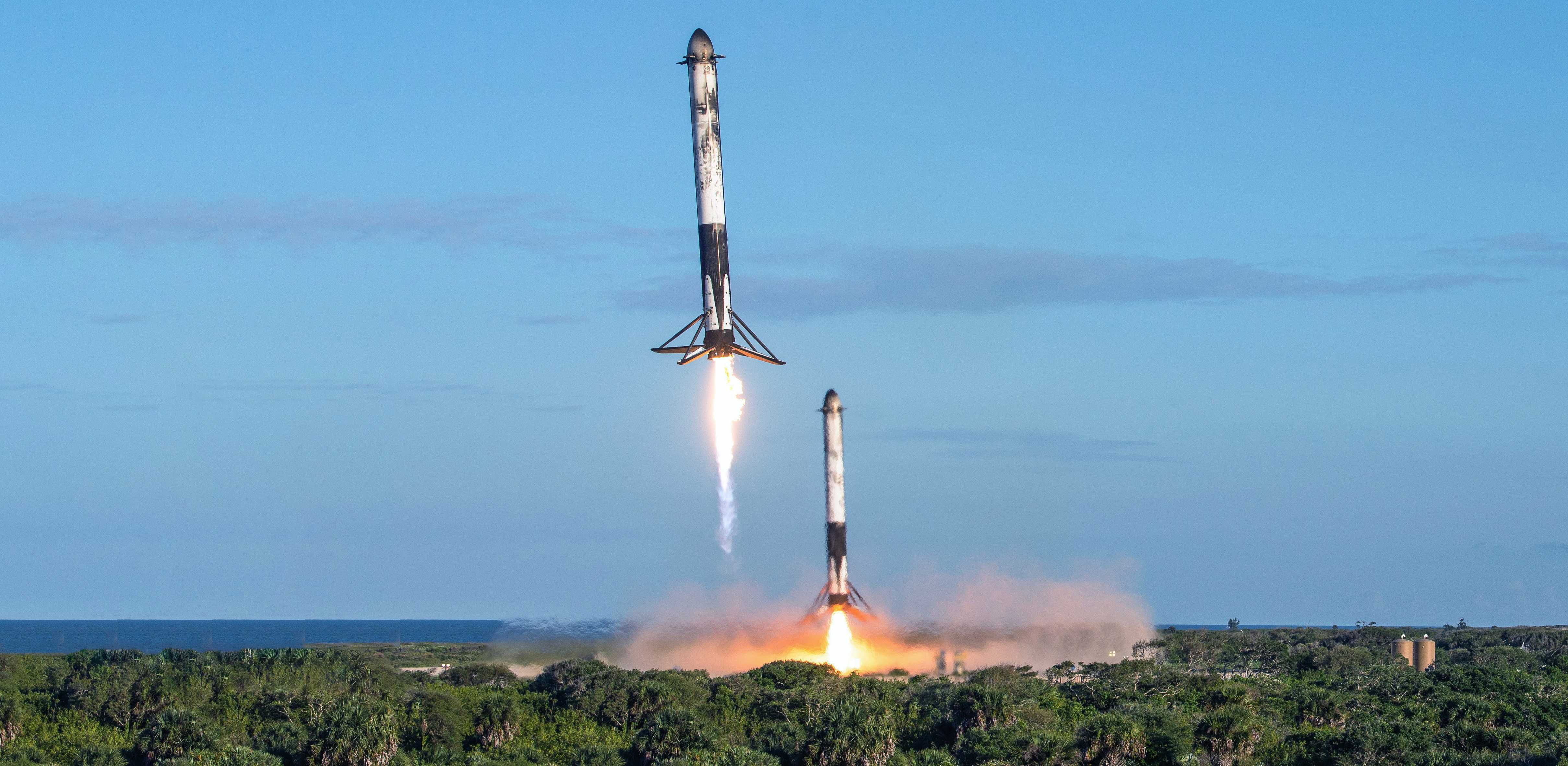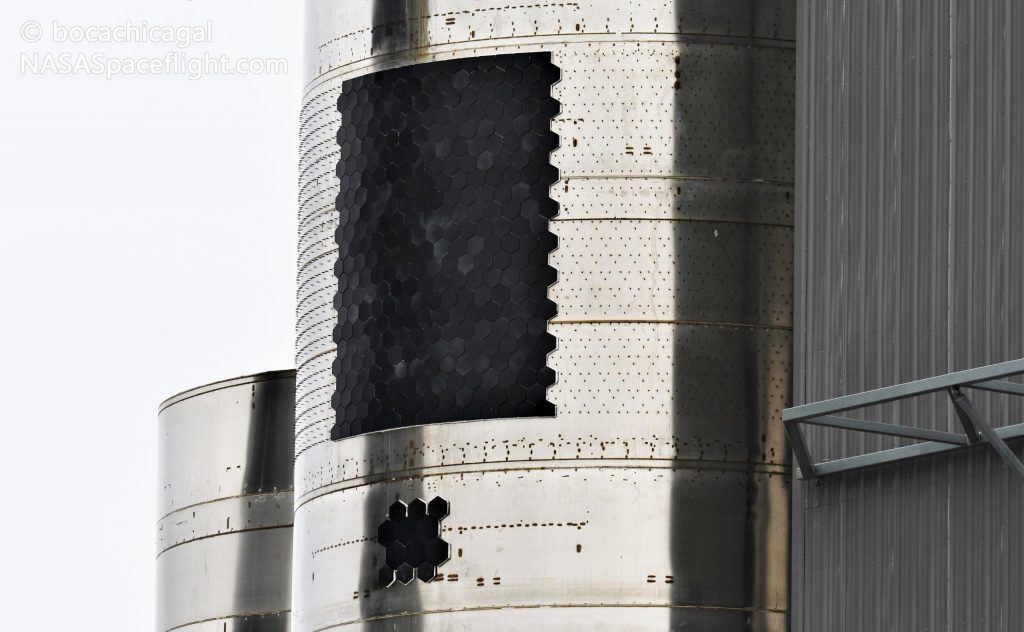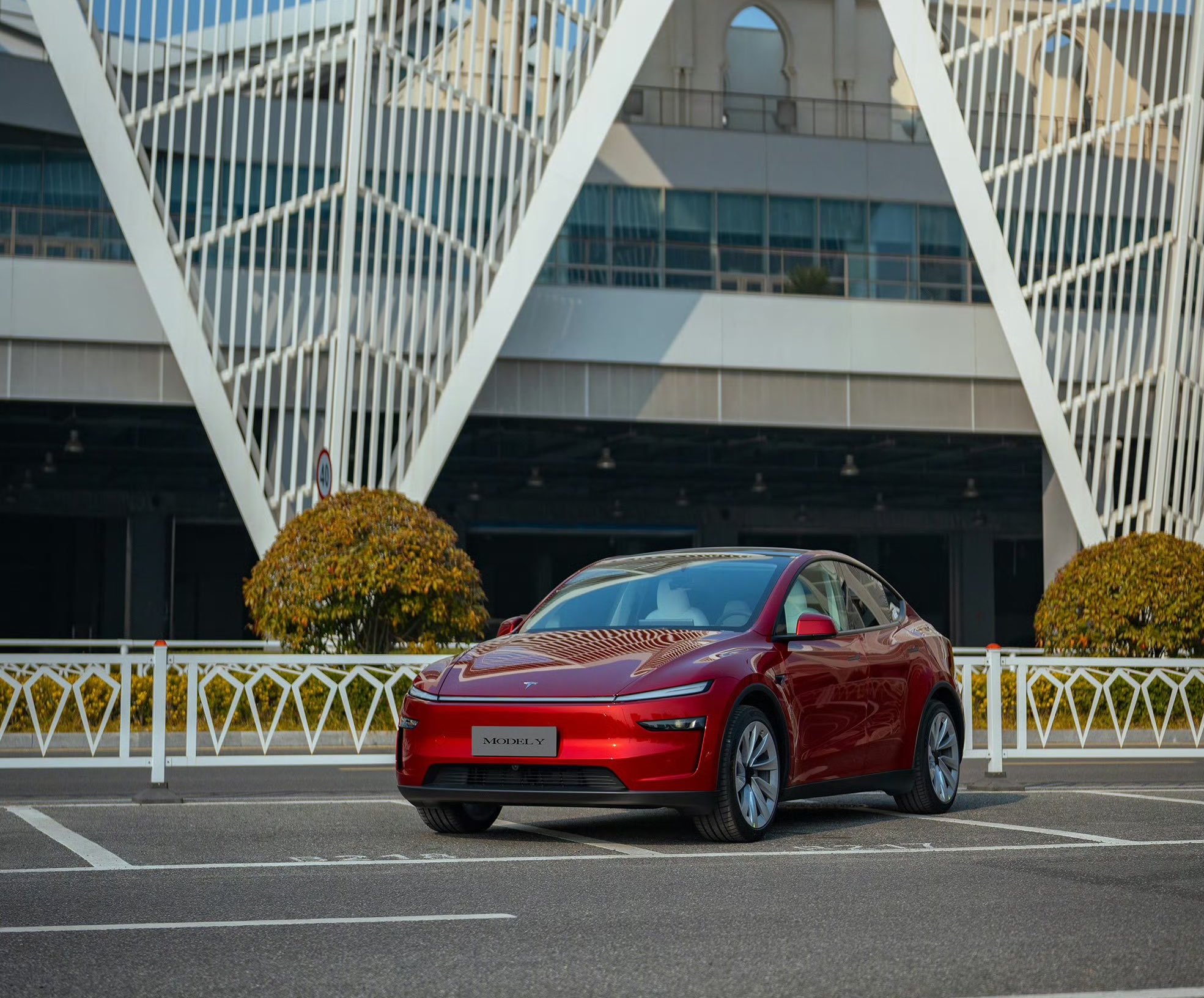

News
SpaceX’s Elon Musk talks Starship heatshield, rocket landings on Joe Rogan podcast
In a multi-hour February 2021 interview with Elon Musk himself, Joe Rogan inexplicably told the famous engineer and CEO that he had never seen a SpaceX rocket landing.
Of course, the 200+ minute conversation did produce a few minor tidbits of interesting information about SpaceX (and much more about Tesla projects), but Rogan’s statement that he’d never seen a SpaceX rocket landing before stole the limelight by a long shot.
SpaceX landed its first Falcon 9 booster – to an extraordinary amount of fanfare – in December 2015. In the five years since that breakthrough, SpaceX has successfully landed Falcon boosters 73 more times. A full 26 of those landings occurred in just the last 12 months. Falcon Heavy – responsible for spectacular, crowd-favorite performances – completed three dual-booster landings and one triple-booster landing between February 2018 and June 2019.
It’s not unimaginable that almost every single human on Earth with some level of access to the internet or social media is at least vaguely aware of or has watched videos of SpaceX landing rockets. To be clear, it is an unequivocal fact – including past comments on landings from Rogan himself – that Rogan has watched SpaceX land Falcon boosters at least once, if not several times. The only real takeaway, fellow readers, is that heavy, long-term drug use is inadvisable.
Cringeworthy moments aside, the interview did produce a select few minor details that weren’t explicitly known before. Most notably, Musk briefly discussed the challenge of developing a heat shield capable of safely returning orbital Starships back to Earth and revealed the main issue that SpaceX is currently working on.

Over the last six or so months, SpaceX has been gradually expanding small installations of heat shield tiles on Starship prototypes, ranging from vehicles that never left the ground to high-altitude Starships SN8 and SN9. Those tile installations have grown from a handful (4-8 on Starhopper in 2019) to literal hundreds on the most recent Starship completed by SpaceX.
During earlier ground testing and more recent hop tests with Starships SN5 and SN6, some of those ceramic composite tiles actually fell off or shattered, perhaps due to vibrations from Raptor engines or mechanical stress caused by Starship shrinking and contracting from thermal expansion. According to Musk, what SpaceX is trying to determine with those coupon-style tests is how to install a heat shield with tiles that are neither too close together or too far apart.

According to Musk, ceramic heat shield tiles placed too close together will ultimately shatter, break, or fall off when subjected to the stresses of Starship operations. Those stresses include the violent vibrations created by rocket propulsion supersonic to hypersonic travel, as well as airframe expansion and contraction that occurs when Starship’s steel hull is cyclically heated and cooled by Raptor burns and cryogenic propellant. In other words, assuming fragile, ceramic tiles are a necessity, they need to be placed far enough apart to avoid all of those possible pitfalls.
On the opposite hand, though, the entire point of Starship’s heat shield is to insulate it from extreme thermal stress during atmospheric reentry. If individual tiles are situated too far apart, superheated gas (plasma) produced during reentry will find its way between those tiles, heating up the structure they’re meant to keep cool. In the case of Starship, its steel hull is more than twice as resilient to reentry heating than comparable vehicles (like the Space Shuttle) with common aluminum frames, but a few millimeters of steel is still not enough to prevent weakening, damage, or outright burn-through in the face of orbital reentry.
In essence, SpaceX has to “get the gaps just right” – not too far apart to protect the airframe from plasma intrusion but not so close together that tiles impact or damage their neighbors as Starship cools and warms.
Elon Musk
Tesla analysts believe Musk and Trump feud will pass
Tesla CEO Elon Musk and U.S. President Donald Trump’s feud shall pass, several bulls say.

Tesla analysts are breaking down the current feud between CEO Elon Musk and U.S. President Donald Trump, as the two continue to disagree on the “Big Beautiful Bill” and its impact on the country’s national debt.
Musk, who headed the Department of Government Efficiency (DOGE) under the Trump Administration, left his post in May. Soon thereafter, he and President Trump entered a very public and verbal disagreement, where things turned sour. They reconciled to an extent, and things seemed to be in the past.
However, the second disagreement between the two started on Monday, as Musk continued to push back on the “Big Beautiful Bill” that the Trump administration is attempting to sign into law. It would, by Musk’s estimation, increase spending and reverse the work DOGE did to trim the deficit.
Every member of Congress who campaigned on reducing government spending and then immediately voted for the biggest debt increase in history should hang their head in shame!
And they will lose their primary next year if it is the last thing I do on this Earth.
— Elon Musk (@elonmusk) June 30, 2025
President Trump has hinted that DOGE could be “the monster” that “eats Elon,” threatening to end the subsidies that SpaceX and Tesla receive. Musk has not been opposed to ending government subsidies for companies, including his own, as long as they are all abolished.
How Tesla could benefit from the ‘Big Beautiful Bill’ that axes EV subsidies
Despite this contentious back-and-forth between the two, analysts are sharing their opinions now, and a few of the more bullish Tesla observers are convinced that this feud will pass, Trump and Musk will resolve their differences as they have before, and things will return to normal.
ARK Invest’s Cathie Wood said this morning that the feud between Musk and Trump is another example of “this too shall pass:”
BREAKING: CATHIE WOOD SAYS — ELON AND TRUMP FEUD “WILL PASS” 👀 $TSLA
She remains bullish ! pic.twitter.com/w5rW2gfCkx
— TheSonOfWalkley (@TheSonOfWalkley) July 1, 2025
Additionally, Wedbush’s Dan Ives, in a note to investors this morning, said that the situation “will settle:”
“We believe this situation will settle and at the end of the day Musk needs Trump and Trump needs Musk given the AI Arms Race going on between the US and China. The jabs between Musk and Trump will continue as the Budget rolls through Congress but Tesla investors want Musk to focus on driving Tesla and stop this political angle…which has turned into a life of its own in a roller coaster ride since the November elections.”
Tesla shares are down about 5 percent at 3:10 p.m. on the East Coast.
Elon Musk
Tesla scrambles after Musk sidekick exit, CEO takes over sales
Tesla CEO Elon Musk is reportedly overseeing sales in North America and Europe, Bloomberg reports.

Tesla scrambled its executives around following the exit of CEO Elon Musk’s sidekick last week, Omead Afshar. Afshar was relieved of his duties as Head of Sales for both North America and Europe.
Bloomberg is reporting that Musk is now overseeing both regions for sales, according to sources familiar with the matter. Afshar left the company last week, likely due to slow sales in both markets, ending a seven-year term with the electric automaker.
Tesla’s Omead Afshar, known as Elon Musk’s right-hand man, leaves company: reports
Afshar was promoted to the role late last year as Musk was becoming more involved in the road to the White House with President Donald Trump.
Afshar, whose LinkedIn account stated he was working within the “Office of the CEO,” was known as Musk’s right-hand man for years.
Additionally, Tom Zhu, currently the Senior Vice President of Automotive at Tesla, will oversee sales in Asia, according to the report.
It is a scramble by Tesla to get the company’s proven executives over the pain points the automaker has found halfway through the year. Sales are looking to be close to the 1.8 million vehicles the company delivered in both of the past two years.
Tesla is pivoting to pay more attention to the struggling automotive sales that it has felt over the past six months. Although it is still performing well and is the best-selling EV maker by a long way, it is struggling to find growth despite redesigning its vehicles and launching new tech and improvements within them.
The company is also looking to focus more on its deployment of autonomous tech, especially as it recently launched its Robotaxi platform in Austin just over a week ago.
However, while this is the long-term catalyst for Tesla, sales still need some work, and it appears the company’s strategy is to put its biggest guns on its biggest problems.
News
Tesla upgrades Model 3 and Model Y in China, hikes price for long-range sedan
Tesla’s long-range Model 3 now comes with a higher CLTC-rated range of 753 km (468 miles).

Tesla has rolled out a series of quiet upgrades to its Model 3 and Model Y in China, enhancing range and performance for long-range variants. The updates come with a price hike for the Model 3 Long Range All-Wheel Drive, which now costs RMB 285,500 (about $39,300), up RMB 10,000 ($1,400) from the previous price.
Model 3 gets acceleration boost, extended range
Tesla’s long-range Model 3 now comes with a higher CLTC-rated range of 753 km (468 miles), up from 713 km (443 miles), and a faster 0–100 km/h acceleration time of 3.8 seconds, down from 4.4 seconds. These changes suggest that Tesla has bundled the previously optional Acceleration Boost for the Model 3, once priced at RMB 14,100 ($1,968), as a standard feature.
Delivery wait times for the long-range Model 3 have also been shortened, from 3–5 weeks to just 1–3 weeks, as per CNEV Post. No changes were made to the entry-level RWD or Performance versions, which retain their RMB 235,500 and RMB 339,500 price points, respectively. Wait times for those trims also remain at 1–3 weeks and 8–10 weeks.
Model Y range increases, pricing holds steady
The Model Y Long Range has also seen its CLTC-rated range increase from 719 km (447 miles) to 750 km (466 miles), though its price remains unchanged at RMB 313,500 ($43,759). The model maintains a 0–100 km/h time of 4.3 seconds.
Tesla also updated delivery times for the Model Y lineup. The Long Range variant now shows a wait time of 1–3 weeks, an improvement from the previous 3–5 weeks. The entry-level RWD version maintained its starting price of RMB 263,500, though its delivery window is now shorter at 2–4 weeks.
Tesla continues to offer several purchase incentives in China, including an RMB 8,000 discount for select paint options, an RMB 8,000 insurance subsidy, and five years of interest-free financing for eligible variants.
-

 Elon Musk1 day ago
Elon Musk1 day agoTesla investors will be shocked by Jim Cramer’s latest assessment
-

 News6 days ago
News6 days agoTesla Robotaxi’s biggest challenge seems to be this one thing
-

 News2 weeks ago
News2 weeks agoTesla’s Grok integration will be more realistic with this cool feature
-

 Elon Musk2 weeks ago
Elon Musk2 weeks agoElon Musk slams Bloomberg’s shocking xAI cash burn claims
-

 News2 weeks ago
News2 weeks agoTesla China roars back with highest vehicle registrations this Q2 so far
-

 News2 weeks ago
News2 weeks agoTexas lawmakers urge Tesla to delay Austin robotaxi launch to September
-

 News2 weeks ago
News2 weeks agoTesla dominates Cars.com’s Made in America Index with clean sweep
-

 Elon Musk1 week ago
Elon Musk1 week agoFirst Look at Tesla’s Robotaxi App: features, design, and more














